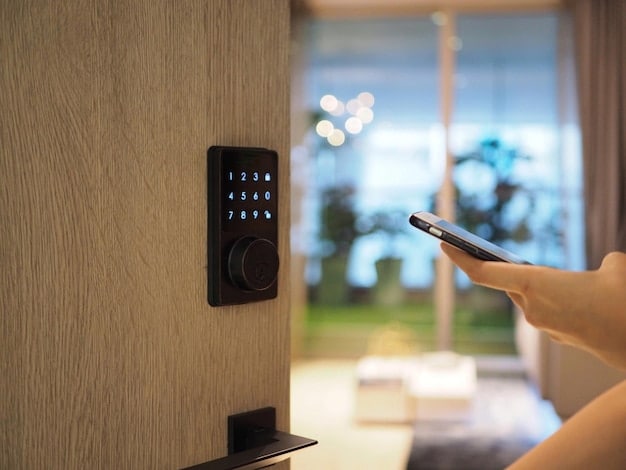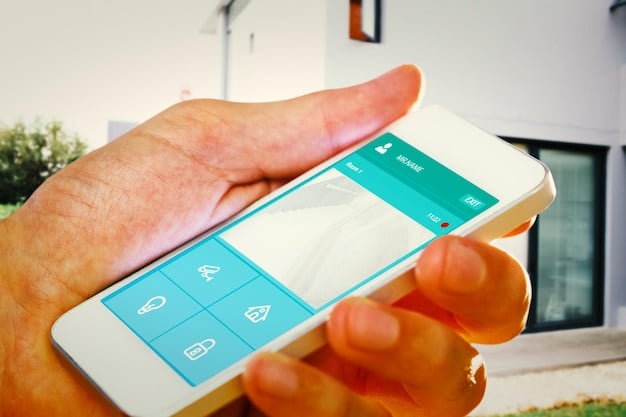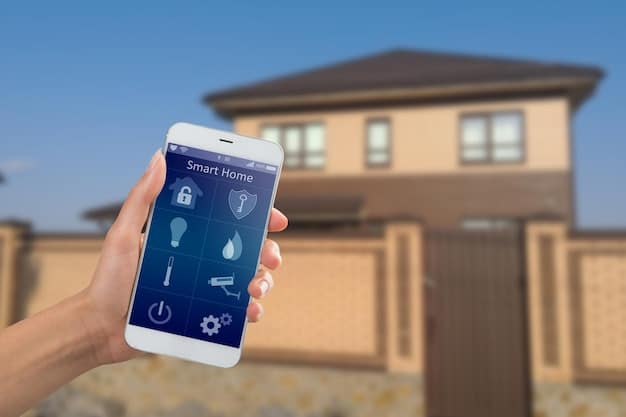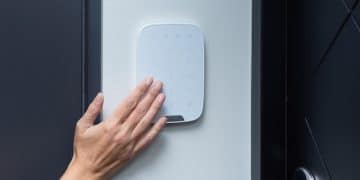Secure Your Smart Lock: 5 Tips to Prevent Hacking

Discover five essential insider tips to secure your smart lock, preventing hacking and unauthorized access, ensuring your home’s safety and peace of mind.
Is your smart lock truly secure? While offering convenience, smart locks can be vulnerable to hacking. Let’s explore Secure Your Smart Lock: 5 Insider Tips to Prevent Hacking and Unauthorized Access to protect your home.
Understanding the Risks of Smart Lock Hacking
Smart locks offer keyless entry and remote control, but they also introduce potential security vulnerabilities. Understanding these risks is the first step in securing your smart home.
Hackers can exploit vulnerabilities in the lock’s software, network connectivity, or even physical components to gain unauthorized access. Knowing common attack methods helps you take preemptive measures.
Common Smart Lock Hacking Methods
Several methods exist that hackers may use to compromise your smart lock. Here are some common techniques and how to defend against them.
- Bluetooth Interception: Hackers can intercept Bluetooth signals during the lock’s operation. Ensure your lock uses strong encryption.
- Wi-Fi Hacking: If your lock connects to your home Wi-Fi, a compromised network can expose your lock. Use a strong, secure Wi-Fi password and network encryption.
- Physical Manipulation: Some locks can be physically bypassed. Choose a lock with robust physical security features and tamper alerts.
By staying informed about these attack vectors, you can take proactive steps to mitigate risks and enhance your smart lock’s security.

Tip 1: Strengthen Your Home Wi-Fi Network
Your smart lock’s security is intrinsically linked to your home Wi-Fi network. A weak or compromised network can provide an entry point for hackers to access your smart lock and other connected devices.
Securing your Wi-Fi network involves several key steps, from choosing a strong password to enabling advanced security protocols. Let’s delve into these measures.
Use a Strong and Unique Password
The foundation of any secure Wi-Fi network is a strong password that’s difficult to crack. Avoid easily guessable passwords like birthdays, names, or common words.
Your password should be at least 12 characters long, including a mix of uppercase and lowercase letters, numbers, and symbols. Regularly update your password to maintain security.
- Password Length: Aim for at least 12 characters.
- Character Variety: Use a mix of letters, numbers, and symbols.
- Password Uniqueness: Do not reuse passwords from other accounts.
By adhering to these password best practices, you significantly reduce the risk of unauthorized access to your Wi-Fi network and connected smart devices.
Tip 2: Enable Two-Factor Authentication (2FA)
Two-factor authentication (2FA) adds an extra layer of security to your smart lock by requiring a second form of verification in addition to your password. This makes it significantly harder for hackers to gain unauthorized access, even if they have your password.
When you enable 2FA, logging into your smart lock account requires a code sent to your phone or email, ensuring only you can access your account. Let’s look at how to set it up.
How to Enable 2FA on Your Smart Lock
Most smart lock systems support 2FA through various methods. Check your lock’s settings in the mobile app to enable this crucial security feature.
Common 2FA methods include SMS codes, authenticator apps, or email verification. Choose the method that best suits your needs and security preferences.
- SMS Codes: Receive a code via text message each time you log in.
- Authenticator Apps: Use apps like Google Authenticator or Authy to generate unique codes.
- Email Verification: Receive a verification code via email for each login attempt.
With 2FA enabled, your smart lock account gains a robust shield against unauthorized access, adding an essential security layer.
Tip 3: Update Firmware Regularly
Smart lock manufacturers release firmware updates to patch security vulnerabilities and improve device performance. Regularly updating your smart lock’s firmware is crucial for maintaining security and preventing hacking attempts.
Firmware updates often address newly discovered security flaws that hackers could exploit to gain unauthorized access. Keeping your firmware up to date ensures you have the latest security patches.
How to Update Your Smart Lock Firmware
Most smart locks have an automatic update feature through their mobile apps. Ensure this feature is enabled to receive updates as soon as they are released.
Alternatively, check for updates manually through the app’s settings. Follow the manufacturer’s instructions to download and install the latest firmware version.
- Automatic Updates: Enable automatic updates in the app settings.
- Manual Checks: Regularly check for updates manually.
- Stay Informed: Follow the manufacturer’s announcements for update releases.
By diligently updating your firmware, you can ensure your smart lock remains protected against evolving security threats, enhancing its overall security posture.

Tip 4: Monitor Access Logs and Notifications
Monitoring access logs and notifications provides valuable insights into your smart lock’s activity. By regularly reviewing these logs, you can detect suspicious activity and potential security breaches.
Smart locks typically offer detailed logs of when the lock was accessed, who accessed it, and any unusual events. Setting up real-time notifications alerts you to any unexpected activity.
How to Monitor Access Logs and Notifications
Access your smart lock’s mobile app to view access logs. Look for entries that seem out of place or at unusual times. Report any suspicious activity immediately.
Enable push notifications to receive real-time alerts when the lock is accessed, when an incorrect code is entered, or if there’s a forced entry attempt. These notifications provide immediate awareness of potential security issues.
- Regularly Review Logs: Check access logs frequently for unusual activities.
- Enable Push Notifications: Receive real-time alerts for lock events.
- Report Suspicious Activity: Immediately report any unauthorized access attempts.
By actively monitoring access logs and notifications, you can promptly identify and respond to security threats, keeping your smart lock and home secure.
Tip 5: Secure Physical Access to Your Smart Lock
While many hacking attempts target the digital aspects of smart locks, physical security is equally vital. Securing the physical access to your smart lock can prevent unauthorized entry and tampering.
Reinforcing the physical security of your smart lock may involve using high-quality hardware, tamper-resistant features, and concealing the lock’s components. Let’s explore some measures.
Reinforce Physical Security Measures
Ensure your smart lock is constructed from robust materials that can withstand physical attacks. Look for locks with tamper-resistant designs and hardened components.
Consider concealing the lock’s wiring and internal mechanisms to make it more difficult for burglars to tamper with it. Protective plates and reinforced strike plates can further enhance physical security.
- Use High-Quality Hardware: Choose locks made from durable materials.
- Conceal Wiring: Protect the lock’s internal mechanisms.
- Reinforce Strike Plates: Use reinforced strike plates to prevent forced entry.
By prioritizing physical security measures, you create a comprehensive defense against both digital and physical attacks, maximizing the security of your smart lock.
| Key Point | Brief Description |
|---|---|
| 🛡️ Strengthen Wi-Fi | Secure your home network with a strong, unique password. |
| 🔐 Enable 2FA | Add an extra layer of security with two-factor authentication. |
| 🔄 Update Firmware | Keep your smart lock’s firmware updated for the latest patches. |
| 🚨 Monitor Logs | Regularly check access logs and notifications for suspicious activity. |
Frequently Asked Questions (FAQ)
▼
Look for unusual activity, such as unexpected lock/unlock events or unauthorized access attempts in the logs. Also, watch for suspicious network activity on your home Wi-Fi.
▼
WPA3 encryption is the most secure option for your home Wi-Fi network. If your router supports it, enable WPA3 for enhanced security.
▼
A VPN (Virtual Private Network) adds an extra layer of security by encrypting your internet traffic, making it more difficult for hackers to intercept data.
▼
It’s a good practice to change your smart lock password every three to six months. Use a strong, unique password each time to prevent unauthorized access.
▼
While some smart locks have physical keyways, high-quality models are designed to be highly resistant to picking. Always choose locks with strong physical security features.
Conclusion
Securing your smart lock involves a combination of robust digital practices and physical security measures. By following these five insider tips, you can significantly reduce the risk of hacking and unauthorized access, ensuring your home remains safe and secure.





